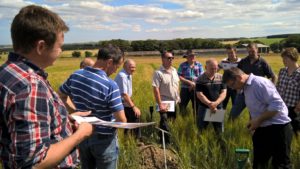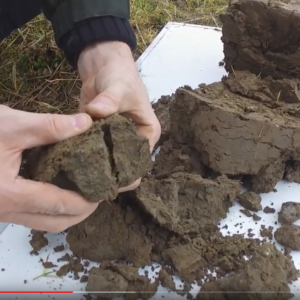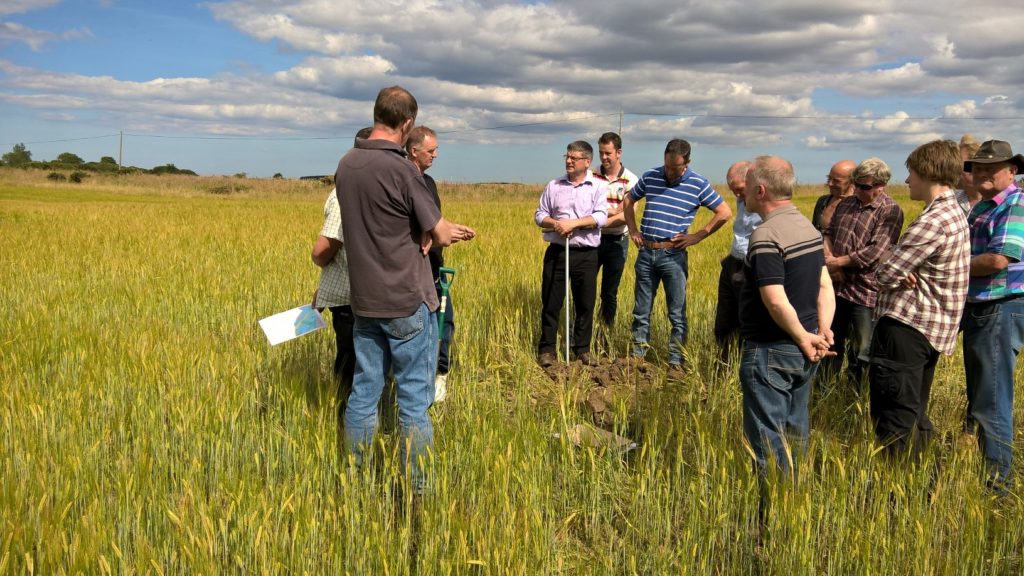Banffshire Soil & Nutrient Network: 1st meeting – event summary
25 July 2018This was the first meeting of the Banffshire Soil and Nutrient Network Farm, hosted by Mr J Beattie of Newmills of Boyne farm, Cornhill.
Newmills of Boyne encompasses a number of different farm units with different soil types requiring careful management. The wet weather conditions experienced in 2017 have resulted in damage to the soils on the farm which has become more apparent with the dry growing conditions experienced in 2018.
The majority of the meeting was spent looking at the soil structure in those areas damaged in 2017. One field showed damage caused by heavy machinery harvesting vegetables. A second field showed similar symptoms in the growing crop but the main issue could be traced back to soil drainage. The meeting discussed options for preventing this damage occurring in the future and also trying to alleviate the damage that had been caused.
Key messages
- Do not forget the basics. While there are numerous different growing systems, fertilisers, fungicide treatments etc, these only work to their potential if the basics such as lime, drainage etc are in place.
- Compaction in the soil can occur at different depths, depending on the cause – livestock, machinery. It is important to know exactly where this compacted layer is.
- Subsoiling is not always the answer, and could in some cases make the situation worse. It is important to consider the drainage system in place in combination with any work to alleviate compaction
- When trying to remove compaction, it is important to use the appropriate tool in the correct conditions. The soil must b
 e dry enough to give a shatter effect while the machine must be capable of getting a few centimetres below the compacted layer. Subsoiling a wet soil is a waste of money and can make the problem worse.
e dry enough to give a shatter effect while the machine must be capable of getting a few centimetres below the compacted layer. Subsoiling a wet soil is a waste of money and can make the problem worse.
Information that was available to take away on the day, and other relevant documents are available to download using the links below.
- Valuing Your Soils – Practical Guidance for Scottish Farmers
- This brochure includes useful information about Scotland's agricultural soils and practical advice outlining the upfront financial savings and business benefits of better soil management and the efficient use of resources. Action and problem-specific 'field-sheets' are designed for busy farmers with limited time for reading.
- Topics: Soils, Climate Change, Water Management and Crops and Soils
- Visual Evaluation of Soil Structure (VESS) Score Chart
- This is a downloadable copy of the Visual Evaluation of Soil Structure (VESS) score chart for use in-field.
- Topics: Soils
- Farming For A Better Climate: Practical Guide – Alleviating Soil Compaction
- This Practical Guide gives some ideas on how to alleviate soil compaction.
- Topics: Soils
- Farming For A Better Climate: Practical Guide – Field Drainage
- Topics: Soils and Water Management
- AHDB: Field Drainage Guide
- AHDB: Field Drainage Guide
- Topics: Climate Change, Soils, Crofts & Small Farms and Water Management
- Farming For A Better Climate: Practical Guide – Improving Soil Quality
- This Practical Guide concentrates on how we can improve soil quality to help us to adapt to climate change.
- Topics: Soils
- Practical Guide: Soil sampling I – How to take a soil sample
- This practical guide details what is required to take a soil sample for analysis that is representative of the area sampled.
- Topics: Soils, Climate Change and Water Management
- Practical Guide: Soil sampling II – Benefits to your business
- This practical guide details how soil sampling can benefit businesses by increasing productivity and create efficiencies on fertiliser inputs through better nutrient planning.
- Topics: Soils, Climate Change and Water Management
- Practical Guide: Tyre Selection & Management
- This practical guide explains how to reduce soil damage, improve fuel usage and reduce overall green house gas emissions by selecting the correct tyre size, type and pressure.
- Topics: Climate Change
- Soil Management Practical Guide
- Scottish soils are a valuable store of carbon, particularly the peat soils of the uplands and islands.
- Technical Note (TN656): Soil Information, Texture & Liming Recommendations
- • Web based access to information on your soils on your farm is described. • Soil texture classes of mineral soils are described and identified by hand texturing. • Liming recommendations for different soils and managements are tabulated.
- Topics: Soils
- Technical Note (TN657): Management of Copper in Soils for Cereals
- The soils of Scotland have developed from a range of complex geological parent materials that vary widely in composition. In the relatively young soils over much of the UK, the parent material remains the dominant factor in determining the soil copper status.
- Topics: Soils, Water Management and Crops and Soils
- Technical Note (TN668): Managing Soil Phosphorus
- Efficient soil P management is challenging due to the varying ability of soils to mediate and regulate plant available forms of P. Farmers and land managers in Scotland are now able to access farm level information about their soils making it possible to provide more accurate P management advice.
- Topics: Crops and Soils
Sign up to the FAS newsletter
Receive updates on news, events and publications from Scotland’s Farm Advisory Service


